
Unique Finds: a.k.a. "Cool Stuff" in Archaeology
“What is the coolest thing you’ve ever found?” This is a question I get often yet it is one of the most difficult to answer. Everything that we find provides valuable information for our research of how people lived in the past, so what we think is “cool” may not be what others would say is “cool.” However, there are a few things that I have encountered that have a definite cool factor regardless of who you are.
Sometimes the most interesting things we find in the field are not objects, but architectural or landscape features. During my first year at Monticello I worked on the North Dependency Project which, among other things, uncovered the original, buried surface of the mountaintop. As Jefferson constructed his home on the mountaintop, he cut away the highest part of the mountain and moved that dirt to other sloped areas of the ground, creating a level plateau for his house and the adjacent dependencies, lawns, and garden.
Underneath all the fill used to level the top of Monticello is the sealed, original ground surface of the mountain. The soil in the center of this photo is part of this buried ground surface with several large rocks resting on top of it.
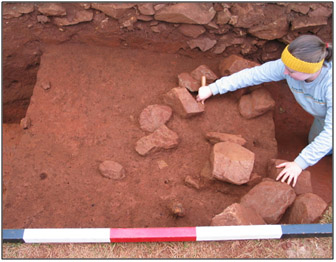
It may look like typical clay, but this was once the topsoil of the mountain and has a more brown appearance and loamy consistency than the fill deposits. This photo includes only a small part of our excavations yet even here the original gradual slope of the mountain is visible. In some areas, Jefferson’s slaves used five feet or more of clay fill to make the mountain level. The next time you’re at Monticello, check out the architectural exhibit in the Visitor Center Galleries which includes a great depiction of how Jefferson transformed the mountain landscape into what we see today.
But what about “cool” stuff? There are a few artifacts in the lab that are what I consider to have a high cool factor due to their uniqueness. One is a cufflink found in the West Kitchen Yard near the South Pavilion. Made from a copper alloy (likely brass), it is comprised of two octagon-shaped discs joined by a long, thin, ovular chain link. Of course we have no way of knowing exactly who wore this small ornament, but I like to think that Jefferson may have worn it given his affinity for octagons.
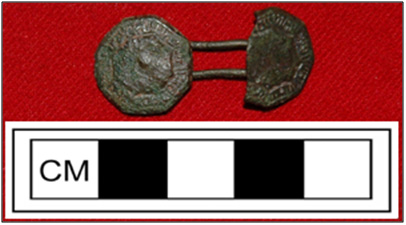
Another of my “favorite” finds comes from Site 8, a grouping of slave quarters for field workers located about a half mile from the mansion. As seen in this photograph of House 1 excavations at Site 8, the sub-floor pits, or small storage pits dug into the ground, are almost all that remains of the structures that once stood at this site.
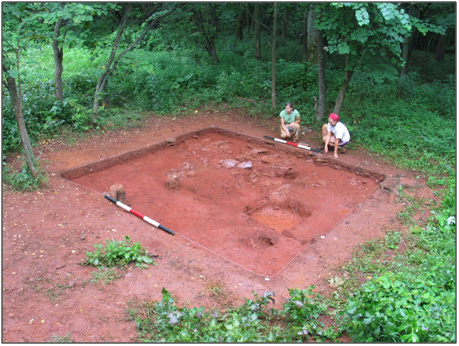
A few summers ago I helped catalogue artifacts from one of these sub-floor pits that included a small “cache,” or cluster, of tobacco pipe fragments. All of the pipes found in the cache are kaolin pipes, which are a kind of European pipe most commonly imported to the Virginia Colony from England. Many of the pipe bowls were broken into multiple pieces, but I was able to reconstruct most of them, as seen here.
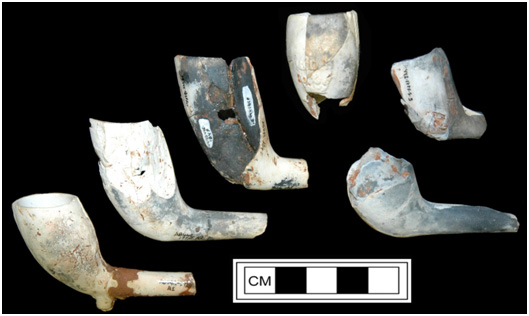
Now, a small cache of six or seven pipes found together is interesting enough, but what was most interesting was that one pipe had a maker’s mark. Finding a complete maker’s mark on a tobacco pipe is not as common as you might think, so I was very excited to see this one. The mark is a little difficult to capture on film, but as seen here it has the initials “H.D.H” above a crown decoration.
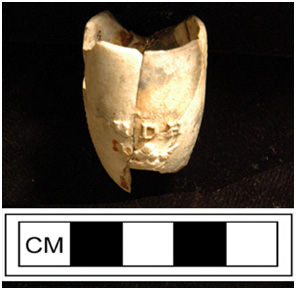
However, I could not identify the maker using any of our references. I was stumped but still determined to discover the maker of this pipe. So I talked with one of my colleagues from the Chesapeake area who suggested I try looking at makers from a country other than England, reminding me that Holland also manufactured these white clay pipes. A quick internet search later, I found a pipe museum in Amsterdam (The Pijpenkabinet) with an extensive collection and a very friendly and knowledgeable curator, Don Duco. And, success! Mr. Duco responded to my inquiry almost immediately with the name of this pipe maker: Huijbert de Hoog. He made inexpensive pipes in Schoonhoven, Holland between 1770 and 1800.
These dates correspond perfectly with our understanding of the occupation at Site 8. Analysis of ceramics indicates that the site was occupied during that same time period and now we have independent evidence to corroborate those findings. Furthermore, this pipe illustrates how enslaved individuals had access to imported goods and were active consumers; research topics constantly investigated here at Monticello. This artifact is one of my favorites because I love it when such a small artifact and some successful research enrich our understanding of the people who called Monticello Plantation home.
All photographs reproduced here are, unless otherwise noted, property of the Monticello Department of Archaeology.


